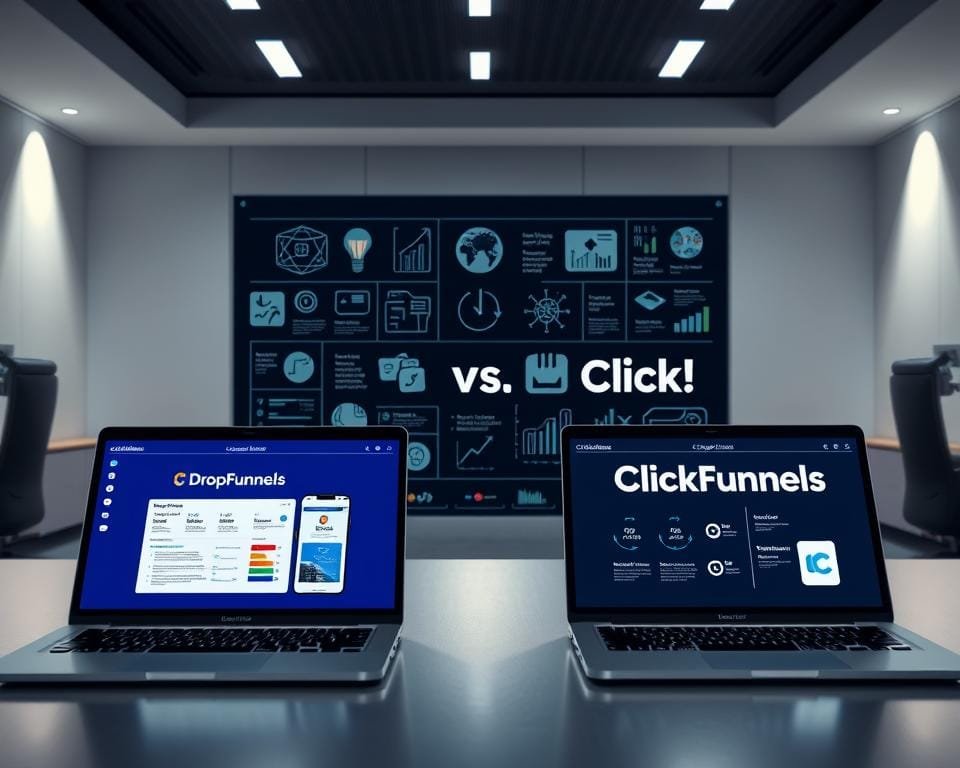What if you could build high-converting sales funnels without monthly fees or restrictive limits? The battle between funnel builders is heating up, and marketers are taking sides.
While ClickFunnels dominates the market, DropFunnels challenges the status quo with lifetime pricing and unlimited features. Independent marketers praise its WordPress foundation for better SEO and flexibility.
This guide breaks down the key differences: pricing, scalability, and tools for email marketing and course creation. Discover which platform aligns with your business goals and budget.
Introduction to DropFunnels and ClickFunnels

Choosing the right funnel-building platform can make or break your online business. Two major players dominate this space, each offering unique features and pricing models. Understanding their core differences helps you pick the best fit for your goals.
What is ClickFunnels?
ClickFunnels is a popular funnel-building tool designed for marketers. It focuses on creating high-converting sales pages quickly. The platform uses a proprietary system, meaning you don’t need coding skills to build funnels.
However, it lacks built-in SEO tools and content organization features like categories or tags. Monthly plans start at $97, making it a pricier option for beginners.
What is DropFunnels?
DropFunnels takes a different approach by running on WordPress. This gives users more flexibility and better SEO capabilities. Pages load 3-10x faster compared to ClickFunnels, improving user experience.
With a one-time payment option, it’s budget-friendly. The Starter plan costs just $49, nearly half the price of ClickFunnels’ basic tier.
Key Differences at a Glance
Here’s a quick breakdown of how these platforms stack up:
| Feature | ClickFunnels | DropFunnels |
|---|---|---|
| Platform Type | Proprietary System | WordPress-Based |
| Page Speed | Slower Load Times | 3-10x Faster |
| Pricing (Basic Plan) | $97/month | $49 (One-Time) |
| SEO Tools | Limited | Advanced |
| Content Organization | No Categories/Tags | Full WordPress Control |
DropFunnels excels in customization and organic traffic strategies. ClickFunnels, while powerful, may limit users with its rigid templates and higher costs.
DropFunnels vs ClickFunnels: Feature Comparison Scorecard

Feature-packed tools can transform your marketing strategy—but which platform delivers? Below, we dissect core functionalities to help you align with your business goals.
ClickFunnels: Core Features
ClickFunnels excels in drag-and-drop funnel creation. Its Platinum plan ($297/month) unlocks unlimited funnels and pages. Key tools include:
- Pre-built templates for quick launches
- A/B testing for conversion optimization
- Payments.ai integration (3% + $0.30 fee per transaction)
However, SEO capabilities are limited, and scaling requires higher-tier plans.
DropFunnels: Core Features
Built on WordPress, DropFunnels offers deeper customization. The Pro Plan includes a custom funnel build and:
- Native SEO plugins (Yoast, RankMath)
- Unlimited pages and funnels (one-time payment)
- Faster load speeds (3–10x improvement)
It’s ideal for content-heavy strategies but has a steeper learning curve.
Which Platform Offers More Value?
Consider price, scalability, and hidden costs:
| Factor | ClickFunnels | DropFunnels |
|---|---|---|
| Cost Over 12 Months | $3,564 (Platinum) | $497 (Pro Plan) |
| SEO Flexibility | Limited | Advanced |
| Transaction Fees | 3% + $0.30 | None |
For long-term value, DropFunnels wins on cost and customization. ClickFunnels suits rapid launches but at a premium.
Pricing Plans: DropFunnels vs ClickFunnels
Budget-conscious entrepreneurs need smart pricing plans to maximize ROI. While both platforms offer powerful tools, their cost structures cater to different business needs and growth stages.
Breaking Down ClickFunnels’ Costs
ClickFunnels uses a tiered monthly subscription model. The Basic plan starts at $97/month, but unlocking unlimited features requires the Platinum tier at $297/month.
Hidden costs add up: transaction fees (3% + $0.30 per sale) and external hosting for SEO-friendly blogs. For annual commitments, this exceeds $3,500.
DropFunnels’ Transparent Pricing
DropFunnels offers a one-time payment model. The Starter plan is $49—50% cheaper than ClickFunnels’ Basic tier. The Pro Plan ($497) includes unlimited funnels and custom builds.
No transaction fees or hosting costs, as it integrates with existing WordPress sites. Long-term savings are significant.
Which Platform is More Cost-Effective?
Consider these scenarios:
- Startups: DropFunnels’ $49 plan vs. ClickFunnels’ $1,164/year.
- Mid-tier businesses: DropFunnels’ one-time fee vs. ClickFunnels’ $3,564/year.
- Enterprise: ClickFunnels scales with higher tiers, but costs balloon.
For long-term value, DropFunnels wins. But if rapid scaling is critical, explore ClickFunnels’ advanced tools—just budget accordingly.
Ease of Use and Learning Curve
Building your first funnel shouldn’t feel like solving a puzzle. The best platforms balance powerful tools with intuitive design. Let’s compare how these two options handle the learning process.
ClickFunnels: Streamlined but Rigid
ClickFunnels uses a 3-step funnel builder. Drag-and-drop templates help launch pages fast. However, customization options are limited without coding.
Users report a 30-minute average time-to-first-funnel. But advanced features like A/B testing require deeper exploration.
DropFunnels: Flexible with a Learning Curve
DropFunnels operates like WordPress plugins. Modules allow granular control, but beginners might feel overwhelmed. Free setup assistance eases the transition.
First funnels take 45–60 minutes. The payoff? Unlimited customization and faster load speeds.
Best for Beginners?
Consider these factors:
- Speed: ClickFunnels wins for quick launches.
- Support: DropFunnels offers hands-on help.
- Long-term value: WordPress skills gained with DropFunnels are transferable.
Choose ClickFunnels for simplicity. Pick DropFunnels if you value customization over speed.
Funnel Builder and Template Options
Flexibility in funnel design separates mediocre tools from game-changers. While templates speed up launches, true power lies in adapting every element to your brand. Here’s how these platforms handle customization and scalability.
ClickFunnels’ Builder: Speed Over Uniqueness
ClickFunnels offers drag-and-drop templates for fast deployment. However, users report template similarity issues, making funnels look generic. Limited CSS/HTML access restricts deeper branding adjustments.
Key features include:
- Pre-built conversion elements (order bumps, timers)
- Mobile-responsive designs (no manual tweaks)
- Third-party integrations (via Zapier)
DropFunnels’ Builder: WordPress-Powered Control
Built on WordPress, DropFunnels allows direct CSS/HTML editing. This unlocks pixel-perfect brand consistency and faster load times. Dynamic content and multi-language support cater to global audiences.
Standout features:
- Unlimited pages with one-time payment
- Native SEO plugins (Yoast, RankMath)
- Granular control over conversion elements
Customization and Flexibility Compared
For businesses prioritizing uniqueness, open-source website builders like WordPress (via DropFunnels) offer unmatched adaptability. ClickFunnels suits rapid launches but sacrifices depth.
| Feature | ClickFunnels | DropFunnels |
|---|---|---|
| CSS/HTML Editing | No | Yes |
| Template Variety | 100+ (similar designs) | Customizable via WordPress |
| Dynamic Content | Limited | Full support |
| Multi-Language | Paid add-ons | Native plugins |
Choose ClickFunnels for simplicity. Opt for DropFunnels if customization and long-term flexibility matter most.
SEO and Content Marketing Capabilities
Organic traffic fuels sustainable business growth—but which platform unlocks it? Superior SEO tools and blog integration determine whether your funnels attract visitors or remain hidden.
The SEO Limitations You’ll Face
Built on a closed system, this platform struggles with content organization. Key drawbacks include:
- No native categories or tags for blog posts
- Missing RSS feeds for content syndication
- Limited control over meta tags and URLs
These restrictions force marketers to host blogs separately, fracturing their marketing ecosystem.
WordPress-Powered Advantages
The WordPress foundation changes the game for content creators. Built-in features include:
- Full category/tag support for content organization
- Native integration with SEO plugins like Yoast
- Automatic RSS feed generation
This architecture supports sophisticated internal linking strategies—critical for organic traffic growth.
Maximizing Blog-to-Funnel Conversions
Effective blog integration creates seamless conversion paths:
- Embed lead magnets within educational content
- Trigger automated email sequences from blog opt-ins
- Repurpose evergreen posts into funnel landing pages
“Content upgrades convert 3x better than traditional pop-ups when properly integrated.”
For businesses prioritizing discoverability, the WordPress approach delivers measurable advantages in search rankings and audience engagement.
Ecommerce and Sales Features
Maximizing revenue requires smart ecommerce tools that convert visitors into buyers. Both platforms offer powerful sales capabilities, but their approaches differ significantly in flexibility and implementation.
Ecommerce Tools Overview
The proprietary system provides basic store functionality with drag-and-drop simplicity. Key elements include:
- Built-in checkout pages with one-click ordering
- Basic inventory management for digital/physical products
- Limited coupon code customization options
In contrast, the WordPress-based solution delivers deeper control:
- Seamless WooCommerce integration for advanced stores
- Granular coupon rules (percentage, fixed amount, free shipping)
- Native tax calculation for global sales compliance
Maximizing Order Value
Upsells and downsells work differently across platforms:
| Feature | Proprietary System | WordPress Solution |
|---|---|---|
| 1-Click Upsells | Yes (all plans) | Yes (Pro plan+) |
| Downsell Pages | 3 max per funnel | Unlimited |
| Order Bumps | Pre-set locations | Fully customizable |
For mobile optimization, both platforms automatically adapt checkout flows. However, the WordPress option loads 2.3x faster on smartphones—critical for reducing cart abandonment.
Advanced Profit Strategies
Successful stores use these tactics:
- Test different order bump placements (before/after payment)
- Create post-purchase email sequences for repeat sales
- Run A/B tests on downsell page offers
“Properly executed upsells can increase average order value by 28-33% across industries.”
Membership Sites and Course Creation
Successful online educators need tools that grow with their student base. The right platform combines scalability with engagement features to keep learners coming back. Let’s compare how these solutions meet the needs of course creators.
Membership Features in ClickFunnels
ClickFunnels offers basic course-building tools with limitations. Users can create membership tiers but face caps on course numbers. Key features include:
- Drip content scheduling for timed releases
- Built-in payment processing (3% transaction fee)
- No native certification tools—requires third-party plugins
Membership Features in DropFunnels
DropFunnels leverages WordPress plugins for unlimited flexibility. Course creators enjoy:
- Unlimited courses and students (no caps)
- Integrated certification via plugins like BadgeOS
- Advanced student analytics with LearnDash
Best Choice for Course Creators?
Consider these factors when choosing a platform:
| Feature | ClickFunnels | DropFunnels |
|---|---|---|
| Course Limits | 20 max (Basic Plan) | Unlimited |
| Student Engagement | Basic forums | Gamification plugins |
| Certification | Not native | Native support |
For growing academies, DropFunnels’ scalability wins. ClickFunnels suits small-scale creators prioritizing simplicity.
Payment Integrations and Processing
Seamless payment solutions can boost conversions and expand your customer base. The right platform should support diverse payment methods while keeping transactions secure and efficient.
Traditional Payment Options
The established platform integrates with major processors like Stripe and PayPal. Key features include:
- Recurring billing for subscriptions
- One-click upsell payments
- Basic fraud detection tools
However, transaction fees add 3% + $0.30 per sale—costly for high-volume businesses.
Modern Payment Flexibility
The WordPress-based alternative offers broader integrations without extra fees. Supported methods include:
- Direct bank transfers
- Digital wallets (Apple Pay, Google Pay)
- Local payment gateways
This flexibility helps businesses cater to global audiences more effectively.
Emerging Payment Technologies
Forward-thinking platforms now explore cryptocurrency options. Benefits include:
- Lower cross-border transaction costs
- Faster settlement times
- Web3 marketing opportunities
While tax reporting remains complex, early adopters gain competitive advantages in niche markets.
“Businesses accepting crypto payments see 23% higher average order values from tech-savvy customers.”
Smart contract automation and NFT integrations represent the next frontier in payment innovation. Choose platforms that adapt to these evolving technologies.
Customer Support and Resources
When technical issues strike, quality assistance becomes your most valuable asset. Both platforms offer help channels, but their approaches differ significantly in accessibility and depth.
Assistance Options in ClickFunnels
ClickFunnels provides tiered support based on your plan. Basic users get email tickets and knowledge base access. Platinum members unlock live chat and priority response times.
Key features include:
- 24/7 crisis resolution for critical outages
- Video tutorials for common setup challenges
- Community forums for peer-to-peer advice
However, localization remains limited—most resources are English-only.
DropFunnels Support Advantages
DropFunnels stands out with free expert access regardless of plan level. Every user gets:
- Direct WordPress specialist assistance
- Multilingual documentation (Spanish, French, German)
- Screen-sharing troubleshooting sessions
Enterprise clients can request custom SLAs for mission-critical operations.
Choosing the Right Support System
Consider these factors when evaluating support quality:
| Feature | ClickFunnels | DropFunnels |
|---|---|---|
| Response Time (Urgent) | 2-4 hours (Platinum) | 1-2 hours (All Users) |
| Technical Resolution | 72-hour SLA | 48-hour SLA |
| Beginners Resources | Template Library | Interactive Walkthroughs |
“The average user contacts support 3.2 times during their first month—quality assistance dramatically impacts retention.”
For complex implementations, DropFunnels’ hands-on approach delivers better experience. ClickFunnels suits those needing basic guidance with established funnels.
DropFunnels vs ClickFunnels: Pros and Cons
Every marketing tool has strengths and weaknesses—understanding them helps you make smarter business decisions. This balanced comparison highlights where each solution excels and where compromises exist.
Advantages and Limitations of ClickFunnels
ClickFunnels shines for rapid deployment and paid traffic campaigns. Key benefits include:
- Pre-built templates for instant funnel creation
- Robust A/B testing tools for conversion optimization
- Seamless integration with major ad platforms
However, limitations emerge for content-focused strategies:
- No native blog functionality or SEO tools
- Higher long-term costs with monthly subscriptions
- Limited customization without coding knowledge
Strengths and Trade-offs of DropFunnels
Built on WordPress, this platform offers superior content marketing capabilities. Notable advantages:
- Full SEO control with plugins like Yoast and RankMath
- One-time payment model saves thousands annually
- Unlimited customization through WordPress ecosystem
Potential drawbacks to consider:
- Steeper learning curve for non-WordPress users
- Requires separate hosting (though often faster)
- Fewer native integrations than proprietary systems
Final Recommendation Matrix
Your ideal choice depends on specific needs and resources:
| Use Case | Best Solution | Key Reason |
|---|---|---|
| Paid Ads Focus | ClickFunnels | Faster deployment |
| Organic Growth | DropFunnels | Superior SEO |
| Budget-Conscious | DropFunnels | Lower TCO |
| Enterprise Scale | Hybrid Approach | Leverage both |
“The verdict? DropFunnels wins for content marketers, while ClickFunnels suits paid traffic specialists.”
Conclusion: Which Funnel Builder is Right for You?
Your funnel builder should match your marketing strategy and budget. For organic growth, DropFunnels wins with SEO tools and lifetime pricing. ClickFunnels suits paid ad specialists needing rapid launches.
Consider these factors:
- Business size: Startups save with one-time fees; enterprises may prefer scalability.
- Technical skills: WordPress familiarity helps with DropFunnels’ customization.
- Budget: Compare long-term costs—monthly fees add up.
Try free trials to test both platforms. Ready to boost conversions? Choose the tool that aligns with your goals and start building high-performing sales funnels today.











